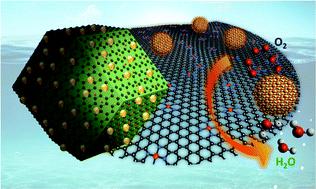当前位置:
X-MOL 学术
›
Energy Environ. Sci.
›
论文详情
Our official English website, www.x-mol.net, welcomes your
feedback! (Note: you will need to create a separate account there.)
Atomically dispersed single iron sites for promoting Pt and Pt3Co fuel cell catalysts: performance and durability improvements
Energy & Environmental Science ( IF 32.4 ) Pub Date : 2021-07-26 , DOI: 10.1039/d1ee01675j Zhi Qiao 1, 2, 3, 4, 5 , Chenyu Wang 5, 6, 7, 8 , Chenzhao Li 5, 9, 10, 11, 12 , Yachao Zeng 1, 2, 3, 4, 5 , Sooyeon Hwang 5, 13, 14, 15 , Boyang Li 5, 16, 17, 18 , Stavros Karakalos 5, 19, 20, 21 , Jaehyung Park 5, 22, 23, 24 , A. Jeremy Kropf 5, 22, 23, 24 , Evan C. Wegener 5, 22, 23, 24 , Qing Gong 5, 9, 10, 11, 12 , Hui Xu 5, 25, 26 , Guofeng Wang 5, 16, 17, 18 , Deborah J. Myers 5, 22, 23, 24 , Jian Xie 5, 9, 10, 11, 12 , Jacob S. Spendelow 5, 6, 7, 8 , Gang Wu 1, 2, 3, 4, 5
Energy & Environmental Science ( IF 32.4 ) Pub Date : 2021-07-26 , DOI: 10.1039/d1ee01675j Zhi Qiao 1, 2, 3, 4, 5 , Chenyu Wang 5, 6, 7, 8 , Chenzhao Li 5, 9, 10, 11, 12 , Yachao Zeng 1, 2, 3, 4, 5 , Sooyeon Hwang 5, 13, 14, 15 , Boyang Li 5, 16, 17, 18 , Stavros Karakalos 5, 19, 20, 21 , Jaehyung Park 5, 22, 23, 24 , A. Jeremy Kropf 5, 22, 23, 24 , Evan C. Wegener 5, 22, 23, 24 , Qing Gong 5, 9, 10, 11, 12 , Hui Xu 5, 25, 26 , Guofeng Wang 5, 16, 17, 18 , Deborah J. Myers 5, 22, 23, 24 , Jian Xie 5, 9, 10, 11, 12 , Jacob S. Spendelow 5, 6, 7, 8 , Gang Wu 1, 2, 3, 4, 5
Affiliation

|
Significantly reducing platinum group metal (PGM) loading while improving catalytic performance and durability is critical to accelerating proton-exchange membrane fuel cells (PEMFCs) for transportation. Here we report an effective strategy to boost PGM catalysts through integrating PGM-free atomically-dispersed single metal active sites in the carbon support toward the cathode oxygen reduction reaction (ORR). We achieved uniform and fine Pt nanoparticle (NP) (∼2 nm) dispersion on an already highly ORR-active FeN4 site-rich carbon (FeN4–C). Furthermore, we developed an effective approach to preparing a well-dispersed and highly ordered L12 Pt3Co intermetallic nanoparticle catalyst on the FeN4–C support. DFT calculations predicted a synergistic interaction between Pt clusters and surrounding FeN4 sites through weakening O2 adsorption by 0.15 eV on Pt sites and reducing activation energy to break O–O bonds, thereby enhancing the intrinsic activity of Pt. Experimentally, we verified the synergistic effect between Pt or Pt3Co NPs and FeN4 sites, leading to significantly enhanced ORR activity and stability. Especially in a membrane electrode assembly (MEA) with a low cathode Pt loading (0.1 mgPt cm−2), the Pt/FeN4–C catalyst achieved a mass activity of 0.451 A mgPt−1 and retained 80% of the initial values after 30 000 voltage cycles (0.60 to 0.95 V), exceeding DOE 2020 targets. Furthermore, the Pt3Co/FeN4 catalyst achieved significantly enhanced performance and durability concerning initial mass activity (0.72 A mgPt−1), power density (824 mW cm−2 at 0.67 V), and stability (23 mV loss at 1.0 A cm−2). The approach to exploring the synergy between PGM and PGM-free Fe–N–C catalysts provides a new direction to design advanced catalysts for hydrogen fuel cells and various electrocatalysis processes.
中文翻译:

用于促进 Pt 和 Pt3Co 燃料电池催化剂的原子分散单铁位点:性能和耐久性改进
显着降低铂族金属 (PGM) 负载量同时提高催化性能和耐久性对于加速质子交换膜燃料电池 (PEMFC) 的运输至关重要。在这里,我们报告了一种有效的策略,通过将碳载体中不含 PGM 的原子分散的单金属活性位点整合到阴极氧还原反应(ORR)中来促进 PGM 催化剂。我们在已经高度 ORR 活性的 FeN 4位点丰富的碳(FeN 4 -C)上实现了均匀且精细的 Pt 纳米颗粒(NP)(~2 nm)分散。此外,我们开发了一种在 FeN 4上制备分散良好且高度有序的 L1 2 Pt 3 Co 金属间化合物纳米颗粒催化剂的有效方法。-C 支持。DFT 计算预测了 Pt 簇与周围 FeN 4位点之间的协同相互作用,通过将Pt 位点上的O 2吸附减弱0.15 eV 并降低活化能以破坏 O-O 键,从而增强 Pt 的内在活性。通过实验,我们验证了 Pt 或 Pt 3 Co NPs 与 FeN 4位点之间的协同作用,导致 ORR 活性和稳定性显着增强。特别是在具有低阴极 Pt 负载量 (0.1 mg Pt cm -2 )的膜电极组件 (MEA) 中,Pt/FeN 4 –C 催化剂实现了 0.451 A mg Pt -1的质量活性并在 30 000 次电压循环(0.60 至 0.95 V)后保留了 80% 的初始值,超过了 DOE 2020 的目标。此外,Pt 3 Co/FeN 4催化剂在初始质量活性(0.72 A mg Pt -1)、功率密度(0.67 V 时为824 mW cm -2)和稳定性(1.0 时损失 23 mV)方面实现了显着增强的性能和耐久性。厘米-2 )。探索铂族金属和不含铂族金属的 Fe-N-C 催化剂之间协同作用的方法为设计用于氢燃料电池和各种电催化过程的先进催化剂提供了新的方向。
更新日期:2021-08-02
中文翻译:

用于促进 Pt 和 Pt3Co 燃料电池催化剂的原子分散单铁位点:性能和耐久性改进
显着降低铂族金属 (PGM) 负载量同时提高催化性能和耐久性对于加速质子交换膜燃料电池 (PEMFC) 的运输至关重要。在这里,我们报告了一种有效的策略,通过将碳载体中不含 PGM 的原子分散的单金属活性位点整合到阴极氧还原反应(ORR)中来促进 PGM 催化剂。我们在已经高度 ORR 活性的 FeN 4位点丰富的碳(FeN 4 -C)上实现了均匀且精细的 Pt 纳米颗粒(NP)(~2 nm)分散。此外,我们开发了一种在 FeN 4上制备分散良好且高度有序的 L1 2 Pt 3 Co 金属间化合物纳米颗粒催化剂的有效方法。-C 支持。DFT 计算预测了 Pt 簇与周围 FeN 4位点之间的协同相互作用,通过将Pt 位点上的O 2吸附减弱0.15 eV 并降低活化能以破坏 O-O 键,从而增强 Pt 的内在活性。通过实验,我们验证了 Pt 或 Pt 3 Co NPs 与 FeN 4位点之间的协同作用,导致 ORR 活性和稳定性显着增强。特别是在具有低阴极 Pt 负载量 (0.1 mg Pt cm -2 )的膜电极组件 (MEA) 中,Pt/FeN 4 –C 催化剂实现了 0.451 A mg Pt -1的质量活性并在 30 000 次电压循环(0.60 至 0.95 V)后保留了 80% 的初始值,超过了 DOE 2020 的目标。此外,Pt 3 Co/FeN 4催化剂在初始质量活性(0.72 A mg Pt -1)、功率密度(0.67 V 时为824 mW cm -2)和稳定性(1.0 时损失 23 mV)方面实现了显着增强的性能和耐久性。厘米-2 )。探索铂族金属和不含铂族金属的 Fe-N-C 催化剂之间协同作用的方法为设计用于氢燃料电池和各种电催化过程的先进催化剂提供了新的方向。










































 京公网安备 11010802027423号
京公网安备 11010802027423号